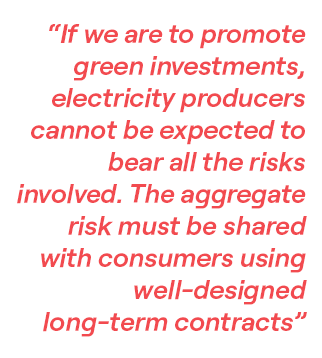In response to the 2022 energy crisis, European regulators agreed to reduce dependency on volatile fossil fuel prices. The EU’s electricity market reform was formally adopted in May 2024, expanding the use of long-term contracts to support the green transition. As part of the TSE Energy and Climate Center’s efforts to inform policy decisions and the public debate, a new TSE working paper analyzes the impact of these measures and underlines the importance of sharing risk.
Why is electricity market design so crucial to EU policy goals?
Global warming and Russia's invasion of Ukraine have focused minds on Europe’s perilous dependency on fossil fuels. The design of its electricity market will determine to what extent sustainability and self-sufficiency goals can be achieved, and at what cost. It must provide reliable price signals to attract the massive funds needed to develop renewable energies, reassuring investors that new power plants will be financially viable. To date, investors have been discouraged by lack of long-term visibility on green policies and underpriced carbon emissions.

Electricity market regulators must also ensure efficient use of installed plants. In the short term, the cheapest sources and the most productive uses of electricity should be given priority. By creating a credible price signal of current resource scarcity, the wholesale market that dispatches according to merit order responds effectively to this objective.
Dominant incumbents must not be able to use market power to hold onto unused capacity during crunch periods between supply and demand, when electricity prices are already high. It is also important to discourage rent-seeking behavior elsewhere. Generation capacity sold forward by an incumbent operator must be sold at a market price, not a price of convenience.
Another key challenge is to keep prices affordable and cover costs. Electricity is not easily stored so spot prices vary considerably, depending on fluctuations in supply and demand. Longer-term uncertainty about the average price of electricity can wreak havoc with corporate and household budgets. To reduce volatility, market -based solutions can encourage the use of smart meters, more flexible production technologies, and improved electricity storage.
Which market instruments can help to address these challenges?
Competitive long-term contracts are an effective way to incentivize investment and limit abuse of market dominance. These include Purchasing Power Agreements (PPAs), also known as physical contracts, in which buyers and sellers agree in advance on the price and quantity to be delivered.
In contrast, a Contract for Differences (CfD) does not imply any obligation to deliver or withdraw electricity. Instead, it acts as mutual insurance by setting a nominal quantity for calculating financial transfers. Any electricity exchange is remunerated at the market price. If this is below the contract price, the seller is paid the difference. If the market price is higher, the buyer receives the difference.
Ideally, the volume specified in a CfD contract should correspond to the plant’s projected production. This partially insures the producer, allowing adaptation to market conditions. CfDs can also curb market power: even dominant producers will be reluctant to raise prices if buyers must be compensated.
Given their insurance benefits, why are long-term contracts not in wider use?
A key reason is the expectation that governments will come to the rescue in the event of insolvency. Bailouts generate the wrong incentives but can be hard to avoid when prices are high and politically powerful lobbies are not insured. Vertical integration can also reduce futures liquidity. For example, an electricity producer who is also an electricity retailer is "naturally hedged", with little incentive to participate in the futures market.
A crucial remedy is to mandate insurance, forcing electricity to be bought or sold on the forward market or to be hedged with a long-term financial contract. Monitoring of solvency or the use of margin calls may help to alleviate uncertainty about insurers’ ability to meet their commitments.
Why do Europe’s reforms fail to use these tools effectively?
The recent reforms seek to encourage, but not force, the signing of both types of long-term contracts (PPAs and CfDs). However, in the EU’s version of the CfD, compensation is only paid if delivery occurs, allowing suppliers to choose not to produce without facing any penalty. This mix of financial and physical features fails to disconnect the insurance part of the contract from the dispatching part. We call this “c-CfD”, where “c” refers to conditionality.
EU member states will be authorized to conclude c-CfDs for new decarbonized installations, and for existing assets under more restrictive conditions. While this will reduce risks for green investors without jeopardizing the wholesale market, it is likely to distort competition. Power plants could be called on to produce even when they are not the cheapest. Conversely, electricity may not be supplied even when its production cost is below the market price. By fully insuring the producer against price variations, c-CfDs resemble the guaranteed feed-in tariffs for renewables, which have in some cases led to zero or even negative prices (see this Ambec-Crampes post).
If Europe is to fulfil its climate ambitions, it must give careful consideration to the supply-side stimulus required. The spot electricity market will not disappear under the new regulation, which is a good thing. But Europe’s reforms are silent on the signals to be sent to investors. What reference or “strike price” will be specified in the c-CfDs for new installations? Placing all electricity production under a single-price c-CfD could kill off the market and prevent optimal risk sharing.
How should Europe get ready for the next energy crisis?
 The energy sector is a fulcrum for huge challenges including global warming, geopolitical tensions, and technological upheaval. It will not receive the massive investments it needs to overcome them if electricity producers are expected to bear all the risks involved. The aggregate risk must also be shared with consumers using well-designed long-term contracts.
The energy sector is a fulcrum for huge challenges including global warming, geopolitical tensions, and technological upheaval. It will not receive the massive investments it needs to overcome them if electricity producers are expected to bear all the risks involved. The aggregate risk must also be shared with consumers using well-designed long-term contracts.
Without this mechanism, governments will be forced to adopt knee-jerk measures such as tariff shields and bailouts that place a huge strain on public finances and create collective moral hazard. As well as expanding insurance, Europe should develop institutions to protect the most vulnerable and adapt the retail market to self-consumption, electric mobility, storage and other new energy uses. Unfortunately, the new reforms merely recommend that countries should be able to easily adopt tariff shields in a crisis. We can and must prepare better for the future.
FURTHER READING ‘The design of electricity markets: an economic analysis’ and other related publications are available to view on the TSE website.
Article published in TSE Reflect, June 2024






